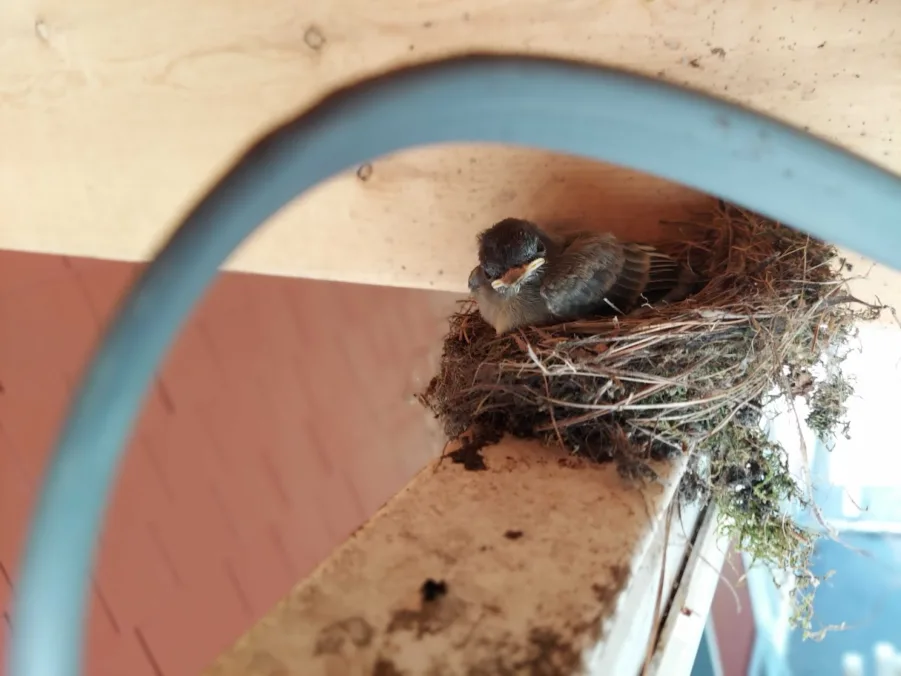While you can enjoy backyard birds year round, the warmer seasons give a more intimate window into their lives. For resident and migratory songbirds, Spring and Summer are the peak times for breeding. This can mean birds nesting around your home, garden, or backyard. For some people, a bird nest at home is an exciting opportunity to learn about how birds live their lives. For others, it may be a confusing and unexpected development. In this Naturalist Answers post, you’ll learn what to do if you find a bird nest at your house.
1. Determine if the nest is active.
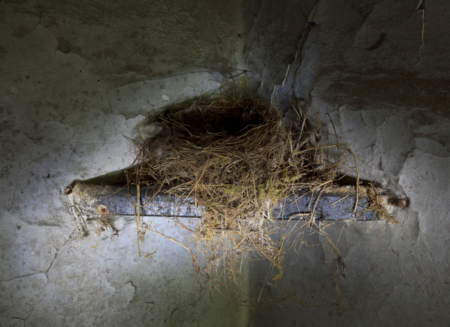
Finding a bird nest on your property doesn’t necessarily mean that you’ll be dealing with a bird family in a few weeks. Sometimes, nests from the previous year last through the Winter and remain present even though they are no longer in use.
If the nest is active, both parents will be visiting frequently. Find a place to sit where you can be out of view from the birds’ perspective and keep an eye on the nest. If you can’t hide behind something, you will want to be 20 yards (~19m) or more away from the nest. Security cameras also work great for monitoring potentially active nests.
Inspecting the nest
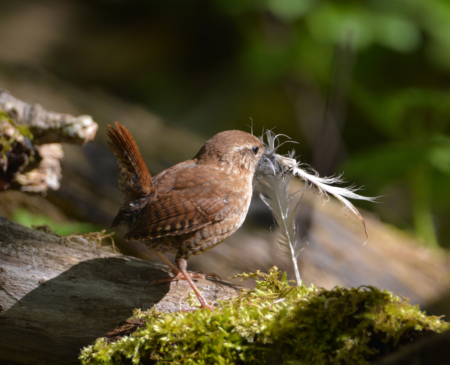
If no birds visit the nest in the span of several hours (or 24+ hours, if you’re using a camera), they have probably abandoned it. If you don’t see any activity around the nest for several hours, it may be safe to check it for structure and contents. Examining a nest near your home, look for:
- Intactness – if the nest cup is incomplete or broken, the nest may not be active
- Nest materials – is the nest just sticks or does it have a complete, soft interior with materials like grass, fur, lichens, mosses, or mud? If parents aren’t visiting an incomplete nest, they have probably abandoned it.
- Leaves or other debris inside the cup – if the nest cup contains leaves, twigs, or other materials, the parents aren’t cleaning it anymore. This typically means that the nest is not active.
Although birds may re-use nests from year to year, it does not do any major harm to remove an inactive nest from your home or property.
2. Identify the species of the nesting birds.
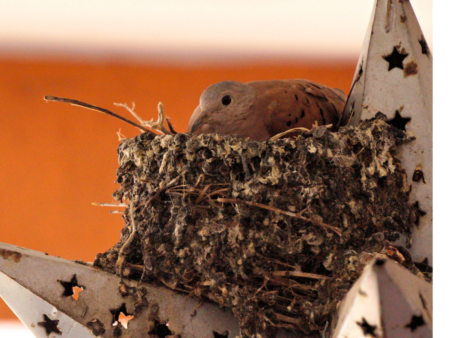
Another important piece of information is the species of the birds to whom the nest belongs. In countries like the United States and Canada that have legal protections for breeding birds, all species but a select few are protected. This means it can be unlawful or illegal to interfere with a bird’s nest once they start to breed.
To be more specific, native breeding bird species are typically protected by law. By contrast, non-native, introduced, and especially invasive species are not protected. For example, if you live in North America and find a house sparrow (Passer domesticus) or common starling (Sturnus vulgaris) nest on your property, you can legally remove it. If the nest belongs to a native bird species, it is illegal to disturb it once they have laid eggs.
Using a pair of binoculars and a field guide is probably the best way to figure out what species you’re dealing with. The Merlin birdwatching app can also help you identify birds from their songs and other vocalizations. Furthermore, our guide to common backyard birds of Eastern North America could provide some good starting points.
3. Check for incubating or feeding behavior.
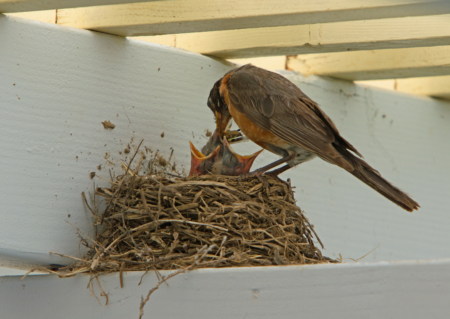
As I mentioned earlier, whether or not the nest contains eggs or young is very important because of laws protecting birds. When a nest does not contain eggs, even if it belongs to birds from a native species, it is still technically legal to remove or relocate it. As soon as they lay even a single egg, however, the nest is under protection of federal law.
Monitor the nest and how the parents behave around it. When they visit, are they carrying sticks, moss, or other nest-building materials? If the nest is still under construction, you can legally remove it if it’s in an unwanted location. Of course, it’s not the nicest thing to do to a pair of hardworking parents!
If you see parents carrying food, there may already be chicks in the nest. Alternatively, for some species, the female may be incubating eggs, and her mate is feeding her on the nest. In either of these cases, it’s illegal to disturb the nest in any way.
Watching parents feed nestlings is also a great way to learn about your neighborhood birds. It’s an especially fun way to get children interested in nature. If you’ve got a nesting pair to keep an eye on, pay attention to their visits. What kind of food are they bringing their young? Is it different every time? How often do they visit?
4. Avoid disturbing the nest.

If there’s an active nest on your property, you will want to avoid disturbing it however possible. Disturbances to the nest, like loud noises or lots of activity nearby can cause the parents to abandon. This is especially sad, because the eggs or chicks still in the nest will not survive.
Primarily, this means minimizing the time you spend near the nest site whenever possible. For some bird species like Northern mockingbirds (Mimus polyglottos) or Australian magpies (Gymnorhina tibicen) this is particularly easy. This is because adults of these species are extremely protective of nests, and will typically swoop down and peck human intruders!
If the nest is in an essential area like a doorway, try to avoid excessive activity in the area. If there’s another doorway available, try using that one instead for a few weeks. This all part of sharing our backyards with wildlife!
5. Look out for fledglings!
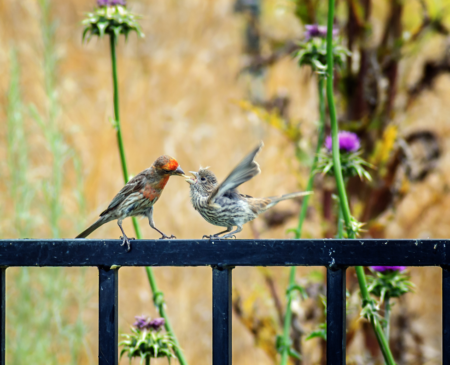
After a few weeks in the nest, altricial young like songbird nestlings leave the nest as fledglings. Although they have feathers by this point, these babies usually still cannot fly for a couple of weeks. They spend their time running on the ground or hopping between branches in small shrubs and trees. Fledglings are still very much dependent on their parents, and will make a lot of noise to keep their attention.
Fledglings are most often what people mistake for abandoned baby birds. Although they aren’t in the nest, they probably left for a reason! Chicks fledge or leave the nest when they are too big for it, and to reduce the chance of being found by a predator. Moving around, they aren’t “sitting ducks”.
Here are some signs that your nest might have fledged:
- You hear begging calls in different parts of your yard from day to day.
- The parents are no longer returning to the nest area, but still carrying food.
- Parents give alarm calls when you walk through certain parts of your yard.
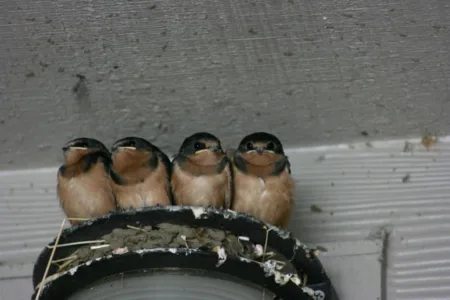
Fledglings often look very ragged and disheveled. They often still have wrinkly, yellowish fringes at the corners of their mouth to help parents feed them. These can look like a comical frown. Notably, they will not have tails yet and will give the impression of hopping, miniature footballs.
What do I do if I have fledglings in my yard?
A good place to start is my post on what to do if you find a baby bird. If it’s a feathered fledgling, the best thing to do is leave it alone and keep an eye out for the parents. Keeping pets away from fledglings is super important, as they aren’t able to fly and escape to defend themselves. Within a couple of weeks, their flight feathers will have come in and they will be in less danger.
Some more frequently asked questions
Can you relocate bird nest at your house?

You can only move or tamper with nests that do not contain eggs. If the parents have not yet laid eggs, you may relocate the next. Unfortunately, parents won’t always accept a nest if it’s moved to a new location that they don’t like.
If it’s Fall or Winter and the birds are all done with their nest, it’s perfectly okay to remove it. However, if you want to have birds nest at your house, it may be better to leave it. Some species will re-use nests, and be more likely to return to places they nested previously where they don’t have to start over again.
How can I protect a bird nest at my house?
The best way to protect a bird nest at your house is to make people aware that it’s there. In the past, I’ve had friends post a sign on their front door or fence alerting people to a bird nest. Alternatively, I once saw some really creative folks use caution tape! Keeping cats indoors, even if its just during the breeding season, can also make a huge difference.
Thanks for reading about what to do if you find a bird nest at your house!
Did you find this post helpful? Have you found a bird nest at your house? Share with us in the comments, or using Social Media and the Contact page. We’d love to hear from you!

